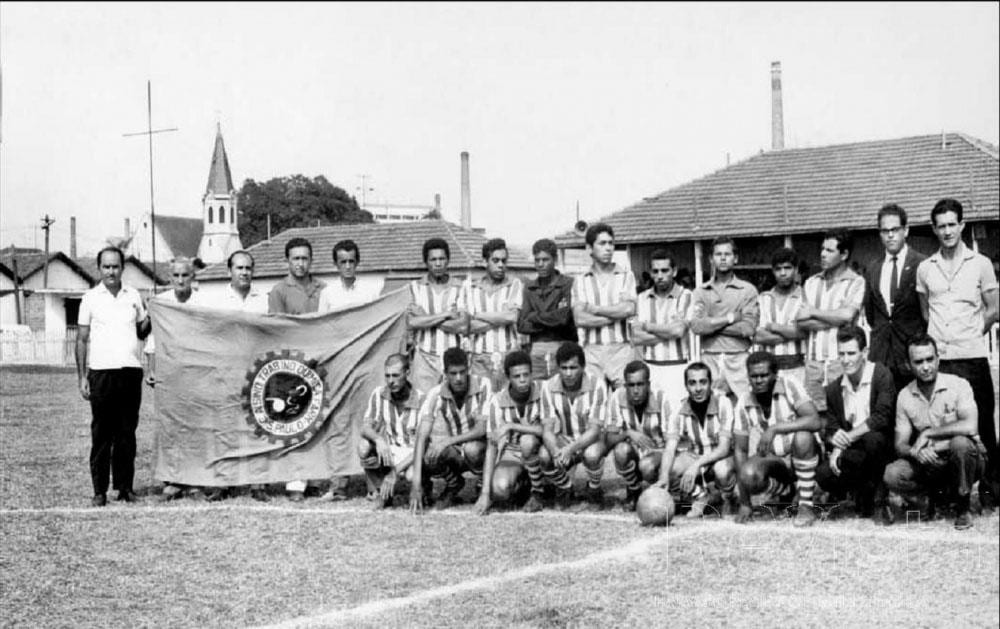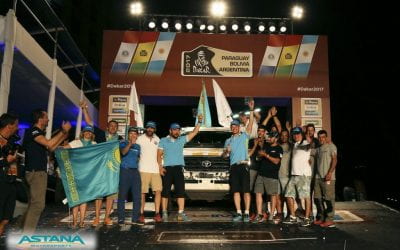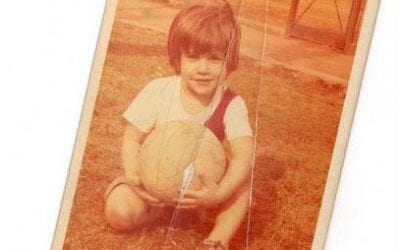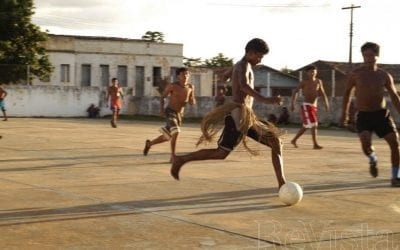Thousands of fans drive to a soccer stadium, a very common scene every Sunday in soccer-mad São Paulo. Brazilians are proud to be five-time World Champions, to be the home of Pelé, Garrincha, Romário, Ronaldo and many other skillful players, who earned Brazil the epithet as the land of the kings of the “beautiful game.”
However, the soccer scene that Sunday, November 13, 2011, looked far from glorious. It was not a match gathering Corinthians, São Paulo F.C. or Palmeiras, the best-known professional soccer clubs in the city. Distant from the glamorous, rich and comfortable world of top professional players, two modest neighborhood clubs were disputing that day the final of the municipal amateur championship, considered to be the largest in Brazil. Despite the humbleness, enthusiasm and spirits were high. For many, the fervor of the fans and the sense of attachment between the local clubs and their communities make amateur soccer, the real soccer, the heir of the best of Brazilian soccer tradition.
In the last decades, the scarcity of playing fields due to state speculation, changes in popular leisure activities and even urban violence made amateur football less visible in the major cities. Nevertheless, after many years of decline and ostracism, amateur football seems to be back in fashion again. Popular major championships, films on the topic and Internet and television coverage are helping to recover, little by little, the lost prestige of this leisure practice, especially in São Paulo.
During the Brazilian soccer golden age between the 1950s and ‘70s, the widespread workouts of amateurs in the main cities of the country spread the familiar idea that amateur football was the cradle of Brazilian soccer. In fact, the majority of professional players started their careers in humble local clubs. In places such as Rio and São Paulo, experts from professional clubs used to pick the best amateurs and hire them in a constant flow from city lots to fame. Since the professionalization of the sport in the 1920s and ‘30s, soccer was one of the forms of upward mobility for working-class youngsters in Brazil.
In cities such as São Paulo, amateur football has a very long history that strongly merges with the trajectory of civil society organization and working-class activism. Introduced through the interaction of the English community with the local population, and cultivated in aristocratic sports clubs of Brazilian/ English elites, soccer quickly spread through the city’s neighborhoods. The sport was soon mastered by the working class, which included the sport in its recreational menu. The move to professionalism in the early 1930s even boosted soccer’s popularity, both as a spectator sport and as a leisure activity. Analysts conservatively calculate there were around 3,000 football amateur popular clubs in São Paulo, involving a very significant part of the working-class population during that decade.
Many of these clubs were related to the new factories and workplaces of the city. Indeed, textile industrialists promoted the creation of company clubs as part of a broader paternalistic industrial relations policy, seeking to discipline and to control the leisure time of the workers. However, it was the working-class neighborhoods that became the locus par excellence for the practice and creation of popular football clubs. In the first half of the century, thousands of these clubs were created in the industrial districts of the city, such as Brás, Mooca, Belenzinho, Bom Retiro and Lapa, among others. This first industrial belt of São Paulo was located near the main rivers and rail lines of the city, with plenty of low and flat land alongside the watercourses. It was in these spaces that the working-class practice of soccer proliferated. These peculiar conditions helped to popularize the term futebol de várzea (lea or field football) for amateur soccer.
Frequently stigmatized by the ruling classes and the police as a space for disorder and violence, this lea football became the most popular leisure activity in the districts of the city and, by the 1930s and 1940s, gained some recognition and legitimization. Until the 1970s, amateur soccer was widely reported on in the popular and sports press. Impressive crowds gathered at many of these amateur games.
After World War II, amateur soccer accompanied the growth of the city, spreading out around the new working-class districts on the outskirts. In every neighborhood, dozens of different clubs and teams were created and constituted a fundamental aspect of working-class leisure and associational practice.
The number of soccer playing fields in São Paulo during the 1950s is a clear indicator of the widespread diffusion of the sport. However, while in the original industrial belt of the city real estate speculation and the canalization of the main central rivers destroyed hundreds of fields, the new outskirts areas had plenty of space for practice. As Afonso José da Silva, an old resident of the outskirts of the city, recalls, “Every new neighborhood had to leave a space, a specific area for a soccer field.” Progressively, a geographical dislocation of working-class sociability was taking place, altering the social conformation of the older and more central industrial areas.
Although football was a predominantly male recreation, women could also explore the clubs as a leisure space. The sport itself was restricted to men, but women were eager spectators, sometimes bringing along the whole family for picnics and parties on the side of the fields. Moreover, the clubs often expanded their activities beyond soccer itself by promoting balls, parties and beauty contests. At best they worked as real centers of working-class leisure and integration, but they also gave rise to varied forms of conflicts and antagonism.
Almost every district and new concentration of people had its own club and soccer team—important for the reinforcement of local identity. The residents frequently considered the teams a sort of representation of their “space,” their “area,” a representation of the place where they lived and shared difficulties but also of solidarity with their neighbors and friends. Therefore, the clubs were also important for the constitution and reinforcement of ties and bonds among specific working-class communities.
The rivalry between clubs from different districts could be fierce. It is not surprising, for instance, to note the huge participation and enthusiasm of the fans and supporters (including women and children) during the local tournaments. The general climate was partisan, and violence and conflicts could frequently break out.
Beyond the localities, the clubs could express ethnic and racial identities or other working-class cleavages. Amateur soccer clubs existed specifically for blacks, international migrants’ groups such as Italians, Spaniards, Hungarians or Portuguese, or internal migrants’ groups from different areas in Brazil. Clubs could even be composed of individuals from specific cities or regions within these countries and states. However, the clubs’ identity exclusiveness could vary a lot. The neighborhood, friendship relations and ties seemed to be more important for club association than other criteria. In this sense the clubs were important forms of popular organization to integrate residents of the same locality. But they achieved more than that.
The so-called football festivals (a sort of championship tournament in which clubs from various districts could play against each other) integrated residents from different neighborhoods, allowed them to get to know the city space and landscape and also stimulated experience exchanges. As early as 1921, neighborhood tournaments were taking place. The District Championship, for instance, gathered together teams representing the main neighborhoods of the city. These clubs and tournaments integrated the São Paulo working class in a communication network that connected the different areas and spaces of the popular city.
The amateur soccer clubs are interesting examples of a network of local and voluntary associations that proliferated in the working-class districts of São Paulo in the years following the World War II. These neighborhood organizations, theSociedades Amigos de Bairro (Neighborhood Friends Society), were the most vocal in demanding infrastructure improvements and social equipment, such as schools and hospitals, for the deprived working-class districts. This neighborhood associationism is a fundamental feature of the working-class culture and political action in São Paulo. In the late ‘50s and early ‘60s, neighborhood associations, trade unions and popular political parties joined forces in demands against inflation, agitating for urban improvements and deep social reforms. During the 1950s trade unions and neighborhood organizations grew increasingly close, including joint participation in local sports clubs. Trade unions used soccer as an instrument to recruit support from its working-class audience, promoting championships and trade-union clubs. During a 1957 general strike in the city, for instance, many meetings and picket lines were organized at amateur football clubs in the neighborhoods.
The supposed borders between the world of labor and the world of residence were frequently crossed by these organizations, reflecting an inclusive class perspective, which took into consideration the diverse dimensions of the workers’ lives. Based on informal relations and on diverse social networks, these local associations were not necessarily permanent entities. Actually, organizational discontinuity was one of the features of these social movements, although this rarely meant absence of struggles for rights. Often leisure activities could be the basis for demanding movements. The long-time trade unionist Waldomiro Macedo, for instance, affirms that “many recreational associations themselves used to claim benefits for their neighborhoods.” Through these clubs, many local politicians got information about the residents and their problems and established fundamental network contacts during the electoral period. It helped them to reinforce their claims of belonging to specific localities, communities or even to the working class as whole.
Amateur soccer clubs were key elements of working-class culture and political action during the 1950s. They were deeply connected with the process of fast industrialization and urbanization in São Paulo and interacted with both the formal and informal world of the workers during that period, helping us to understand the varied facets of working-class lives, including their solidarity and conflict aspects. The creation of new football clubs and teams by informal groups in the different districts and streets of the city also opened a space of relative autonomy for workers facing control by the companies, the entrepreneur organizations concerned with working-class leisure, and the state. Football as a leisure activity was very much part of a clash of aspirations and values among social classes in the Brazilian society—a representation struggle—which helps us to understand not only working-class culture, its sociability and cleavages, but also the classes’ relations at a vital moment of the histories of the city and country.





